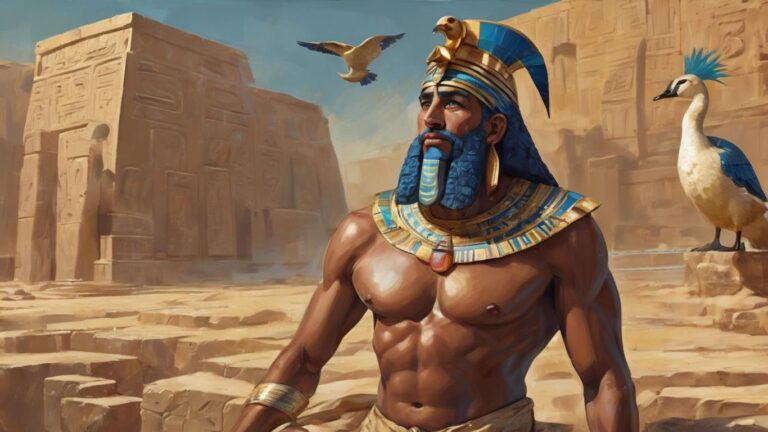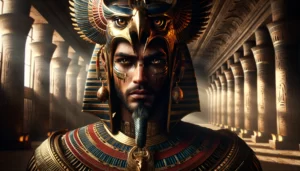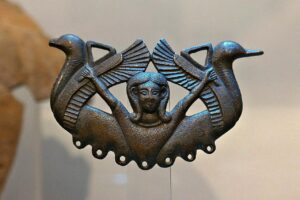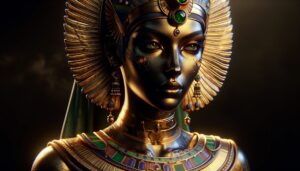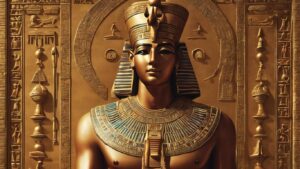Table of Contents
In Egyptian mythology, Geb is the god of the earth. He is one of the Ennead, the nine deities in the Heliopolitan cosmogony of ancient Egypt. Geb is usually depicted as a man lying on the ground with the sky goddess Nut, his sister and wife, arching over him. The separation of Geb and Nut is a significant mythological theme, representing the division between the earth and the sky.
Geb and Nut are also the parents of several important deities in Egyptian mythology, including Osiris, Isis, Seth, and Nephthys. Geb is associated with fertility and vegetation, as the earth is seen as the source of life and abundance.
In Egyptian cosmogony, Geb was initially united with Nut, but their father, the sky god Shu, separated them to establish order in the cosmos. The space between Geb and Nut became the realm in which life on earth exists, and Nut is often depicted as a heavenly goddess adorned with stars, while Geb is the earth beneath.
Origin

In the beginning, Geb emerged from the primordial chaos, a titan born of cosmic forces. Heavens stirred, birthing Geb’s colossal form. Legends intertwined with celestial dance recount Geb’s emergence, a cosmic spectacle that etched his destiny.
Within the celestial forge, stars collided, giving Geb divine vitality. Planets aligned, bestowing upon him wisdom and ancient knowledge. Born of cosmic essence, Geb bore the mark of eternity in his earthly form.
Geb’s colossal limbs shaped the mountains, and his breath breathed life into the valleys. Rivers flowed from his tears, creating a network that nourished the burgeoning world. Transitioning from celestial to terrestrial, Geb became the embodiment of the Earth itself.
As eons passed, Geb’s presence ripened the soil, birthing diverse landscapes. Flora and fauna flourished in the cradle of Geb’s creation, each species a testament to his boundless creativity. Amidst this symphony of life, Geb sculpted continents and carved out oceans with purposeful strokes.
Transitioning through epochs, Geb observed the dance of civilizations atop his vast canvas. Empires rose and fell, leaving echoes in the annals of time. Geb, the silent witness, embraced the ever-changing tapestry of human existence.
In the twilight of epochs, as the stars whispered ancient secrets, Geb’s essence endured. His origin, woven into the fabric of the cosmos, echoed in the winds, and resonated in the beating hearts of all living beings. The genesis of Geb, an eternal saga etched in the cosmic chronicles.
Family
The Egyptian earth deity, is part of the Ennead. His wife is Nut, the sky goddess. Together, they parented Osiris, Isis, Seth, and Nephthys. Nut’s starry expanse arches above Geb. Shu, their father, separated Geb and Nut, bringing order to the cosmos. Geb, with Nut, forms the foundation of Egyptian cosmogony, symbolizing the earthly realm. The sibling relationships in this divine family play crucial roles in Egyptian mythology. The earth, under Geb’s domain, thrives with fertility, mirroring the perpetual cycle of life.
Appearance

The sun dipped below the horizon, casting a golden glow on the ancient city of Geb. Tall obelisks rose, marking the passage of time. Massive stone statues, weathered by centuries, stood sentinel at the city’s entrance.
Geb’s architecture whispered tales of a civilization long forgotten. Intricate hieroglyphs adorned the walls, telling stories etched in the stones themselves. The air buzzed with an otherworldly energy as if the very essence of Geb had a heartbeat.
In the heart of the city, the Great Pyramid soared towards the heavens. Its smooth sides glistened in the fading light, a testament to the architectural prowess of its builders. As the night descended, the pyramid’s peak shimmered with an ethereal glow, a beacon in the vast desert.
Within Geb’s labyrinthine streets, markets bustled with life. Vibrant fabrics adorned stalls, catching the eye of passersby. Exotic spices filled the air, creating a tapestry of scents that lingered in every corner. The people of Geb, clad in richly woven garments, moved with purpose beneath the city’s towering structures.
Transitioning into the quieter outskirts, a tranquil oasis revealed itself. Palm trees swayed gently, their fronds casting shadows on serene pools. The oasis, a haven amid the arid landscape, reflected the dichotomy of life in Geb.
As dawn approached, the first light kissed the city awake. Geb, with its enigmatic allure, stood as a living testament to the eons it had witnessed. In every corner, the spirit of an ancient civilization pulsed, inviting those who dared to explore its mysteries.
Myths
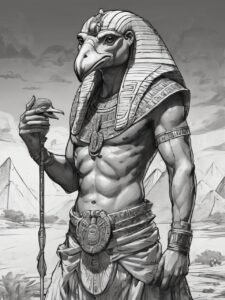
Geb and Nut:
In the ancient Egyptian mythological narrative, Geb, revered as the Earth god, and Nut, the Sky goddess, shared an intimate embrace that rendered them inseparable. Their union symbolized the interconnectedness of the Earth and the heavens. However, this divine embrace troubled Ra, the powerful sun god, who recognized the necessity of creating space for life to flourish. Ra entrusted this task to Shu, the god of air and wind. With unwavering determination, Shu intervened, gently but decisively parting the entwined bodies of Geb and Nut. In doing so, he brought forth the expanse between Earth and Sky, allowing the elements of creation to exist independently. This separation became a pivotal moment in Egyptian cosmogony, setting the stage for the unfolding drama of life, death, and the cyclical renewal of existence within the cosmic order.
Geb and Osiris:
The progenitor of Osiris, Isis, Seth, and Nephthys, witnessed the tragic turn of fate. Osiris, betrayed by Seth, met his demise, sparking a fierce struggle for the throne. The relentless conflict unfurled as Seth sought dominion and Isis sought justice. After Osiris’s demise, Geb and Nut, the cosmic parents, assumed pivotal roles. They guided the resurrection of Osiris in the afterlife, presiding over the judgment of his soul. Amid celestial deliberations, Osiris’s spirit faced trials, and his eternal fate hung in the balance. The cosmic forces of Geb and Nut weighed the deeds of the departed, determining the course of Osiris’s existence beyond the mortal realm. In the celestial tribunal, the essence of Osiris found solace or retribution, marking a profound chapter in the intricate tapestry of Egyptian mythology.
Nut’s Curse
Cursed not to bear children any day, Nut faced a divine obstacle. Thoth, god of wisdom, intervened with cunning. Creating five extra days, he outsmarted fate. In this newfound time, Nut birthed Osiris, Isis, Seth, Nephthys, and Horus. The divine trickery unfolded, defying destiny’s constraints.
The Earth’s Features
Geb, linked with Earth’s physical features, molds mountains, valleys, and rivers. His body shapes the landscape, forming extraordinary terrains. Ancient myths depict Geb as the sculptor, crafting nature’s grand tapestry. In this divine narrative, his influence resonates through the contours of the Earth.
As a Creator:
A creator god, Geb shaped Earth and sustained life. His tears birthed the Nile River. Symbolizing fertility, Geb’s influence transcends myths, intertwining with the essence of existence. Moreover, his celestial tears bestow vitality upon the land, nurturing civilizations along the banks of the Nile.
In Cosmic Mythology:
Emerging from primordial chaos, Geb becomes a cosmic deity. His link to celestial events underscores his mythic significance. Furthermore, Geb’s influence extends beyond Earth, weaving into the cosmic tapestry. In the grand scheme, his presence aligns with the cosmic order, shaping the very fabric of mythology.
These myths highlight Geb’s significance in Egyptian cosmogony, his relationships with other deities, and his influence on the natural world.
FAQ
What is Geb in charge of?
Geb is in charge of the Earth and is considered a god of fertility, vegetation, and the overall sustenance of life.
What does Geb protect?
Geb is believed to protect and govern the earth, its landscapes, and the natural features such as mountains, valleys, and rivers.
Is Geb a god?
Yes, Geb is a god in ancient Egyptian mythology, associated with the earth and its life-sustaining qualities.
How strong is Geb?
In mythology, Geb's strength is symbolic of the earth's solidity and endurance. His strength is often portrayed in a mythic context.
Who did Geb marry?
In mythology, Geb is often mentioned as the husband of Nut, the sky goddess. Together, they are the parents of prominent deities like Osiris, Isis, Seth, Nephthys, and Horus.
Who is the god of earth?
Geb is specifically the god of the earth in ancient Egyptian mythology, embodying the land's fertility and life-giving properties.
